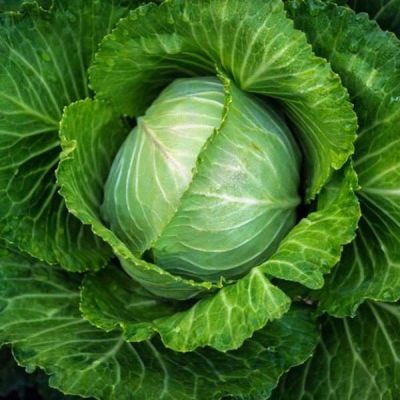
- Authors: Gavrish S.F., Morev V.V., Amcheslavskaya E.V., Volok O.A.
- Year of approval: 2013
- Appointment: for fresh consumption, for canning
- Leaf rosette: raised
- Leaf size: medium size
- Leaf color: light green
- Sheet surface: bubbly
- Outside stump: middle length
- Internal stump: medium to long
- Weight, kg: 0,7-1,3
When choosing a cabbage variety, you should decide on the purpose of the vegetable: you need it for making early salads or for storing for the winter, and also take into account the growing region. For the preparation of vitamin salads, early ripe white cabbage Sugar crunch, which is cultivated in the central part of the Russian Federation, is ideal.
Breeding history
Early cabbage Sugar crunch was bred by scientists of the agricultural firm "Gavrish" in 2010. Authorship belongs to a group of Russian breeders: V.V. Morev, E.V.Amcheslavskaya, and S.V. Gavrish.The vegetable crop was introduced into the State Register of Breeding Achievements of the Russian Federation in 2013. The variety grows especially well in the Central region. It can be located both on garden ridges and under film shelters.
Description of the variety
This cabbage variety is a compact plant with a raised rosette of leaves. It is characterized by medium-sized leaves, which are evenly covered with a light green color. Elongated foliage has a bubbly surface, noticeable thin veins and slightly wavy edges.
Characteristics of the appearance of the plant and heads of cabbage
Cabbage heads ripen smooth and neat. The average head mass ranges from 700 to 1300 grams. The structure of the heads of cabbage is of medium density. The cabbage has a rounded shape. Outside, the vegetable is light green, and inside (on the cut) - snow-white yellow. The inner stump is medium or long, and the outer one is shortened to medium size.
Vegetables cut from the garden can be transported over some distances well, but cabbage does not have a long-term keeping quality. This is due to early ripening and high water (juice) content in the cabbage structure.
Purpose and taste
Sugar crunch is famous for its excellent taste. The flesh of the vegetable is juicy, tender and very crispy. The taste is dominated by pleasant sweetness, combined with a refreshing aroma. Cabbage does not have fiber and excessive wateriness.
A huge advantage of this variety is the valuable composition of the vegetable, which contains magnesium, zinc, phosphorus, iron, calcium, iodine, as well as vitamins A, C, PP, K, U. Cabbage is ideal for dietary nutrition.
Cut heads can be used in the preparation of fresh salads, various cold dishes. Sometimes cabbage is canned.
Ripening terms
The sugar crunch is a class of early cabbage varieties. From mass germination to technical ripeness of vegetables, 100-105 days pass. Having transplanted seedlings to the garden, after 45-55 days you can taste crispy cabbage. Harvesting occurs in June-July.
Yield
The variety produces good yields. On average, 2.3-3.7 kg of identical cabbage heads can be cut from 1 m2 of plantings.
Growing and care
Cabbage is grown in seedlings. To do this, at the beginning of March, seeds are sown for seedlings, which are moved to a permanent place of growth in May.Strong bushes with 4-5 true leaves and a formed root system are considered optimal for transplantation. Transplanting into open ground is carried out under favorable temperature conditions (+ 18-19 degrees for air and + 12-13 for soil). Planting is carried out according to the scheme 50x30 cm. It is recommended to place up to 3 bushes per 1 m2.
Agrotechnology of early cabbage consists of standard procedures: watering with warm water every 3-4 days, fertilizing twice a season, loosening and weeding the soil, single hilling, prevention of diseases and insect infestations. It is also worth noting that not only the root system of the vegetable needs watering, but also the cabbage head itself.

To grow a rich cabbage crop, you need to know when and how to plant this crop outdoors. Planting dates are determined depending on the variety. It is also necessary to properly prepare the soil and follow the rules of crop rotation.


Soil requirements
Cabbage is an unpretentious culture, so there is no need to select special substrates, the main thing is that the soil is fluffy, loose, fertile, breathes well and allows moisture to pass through. Attention should be paid to the acidity of the soil, the indicator of which should not exceed 5 pH.

Cabbage requires particularly careful care when growing. The plant quickly absorbs nutrients, so the soil needs to be enriched regularly. Adequate amounts of minerals, organics and nitrogen must be provided. Some products can be purchased at the store, while others are easy to make at home.
Required climatic conditions
Vegetable culture has good stress resistance, so it can withstand temperature fluctuations, slight cold snaps and heat. The vegetable is susceptible only to prolonged shade, so planting should be carried out in sunny and well-lit areas.
Disease and pest resistance
The immune system of a vegetable is average, so it is often exposed to various diseases, such as black rot (bacteriosis), keela, peronosporosis. To prevent diseases, it is imperative to observe crop rotation, agricultural rules, and also not to forget about prevention. In addition, the culture is sometimes attacked by pests: aphids, cabbage fly, white hare caterpillar, cruciferous bug. Spraying plants with biological preparations will help get rid of pests.

Cabbage is a very popular horticultural crop. But growing a good, large and tasty cabbage is sometimes very difficult, because it is often affected by a huge number of diseases and pests. The main role in the cultivation of this vegetable is played by regular prevention, which helps to get a rich harvest, and prevent the occurrence of diseases and the invasion of harmful insects. It is very important to start treatment as early as possible, otherwise there is a risk of spreading the infection to still unaffected plants.























































































